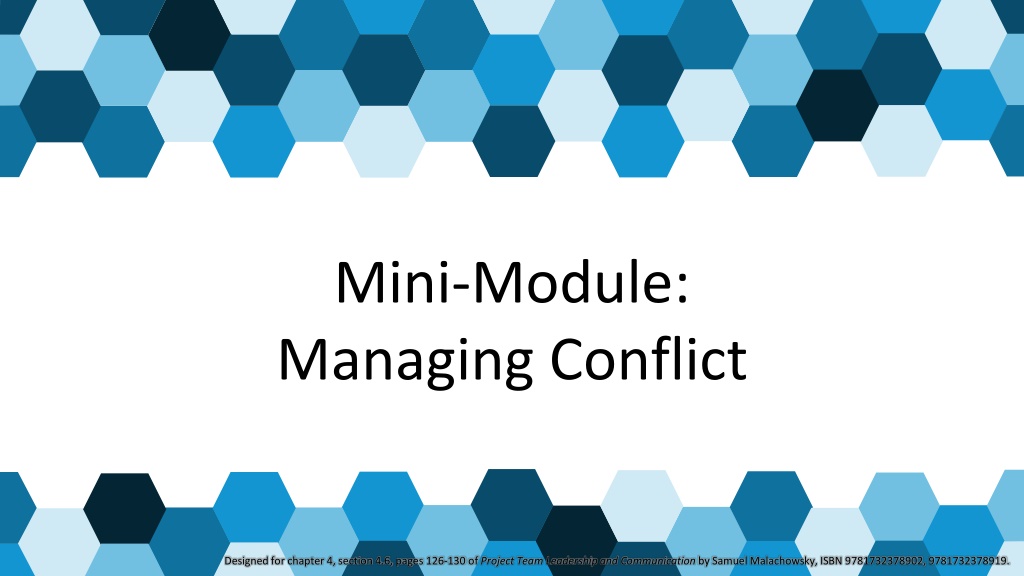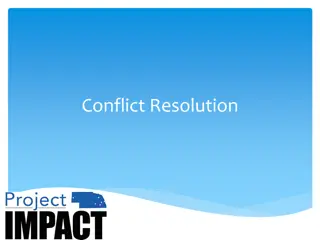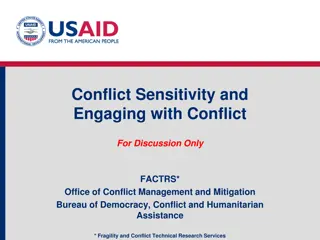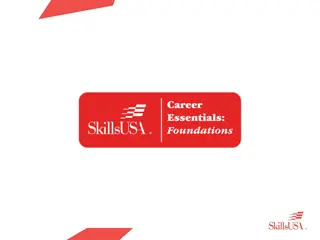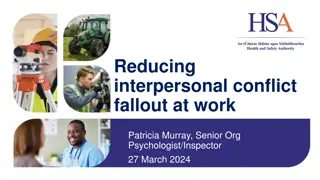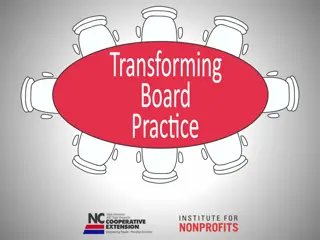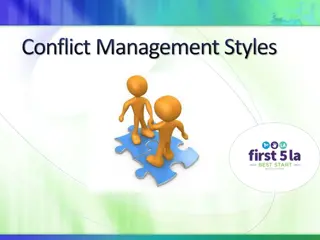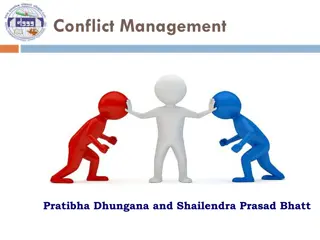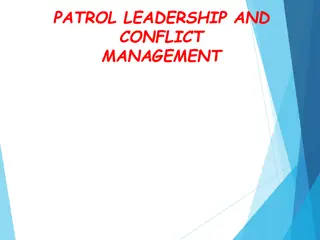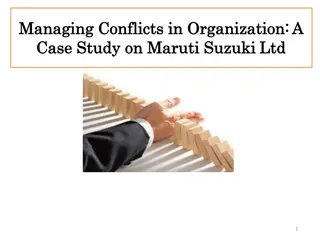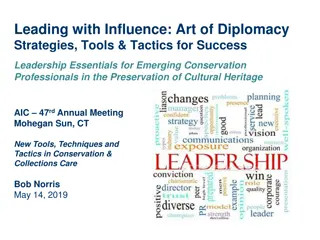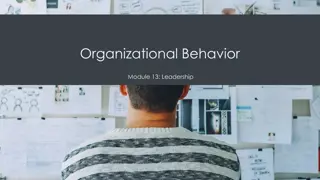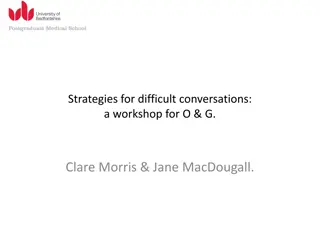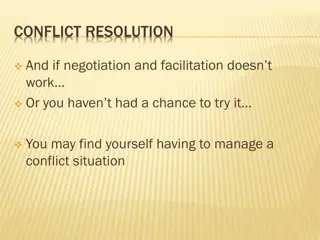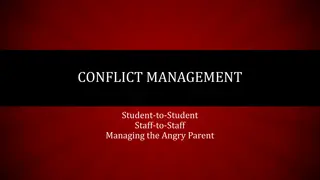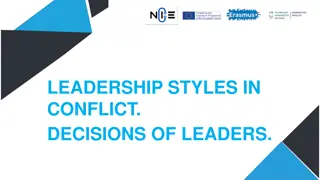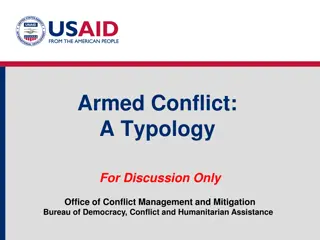Effective Conflict Management Strategies in Team Leadership
Managing conflict within a team is crucial for productive collaboration. Healthy debates lead to better decisions, but rules and norms must be set for constructive conflict resolution. Methods include confronting problems, compromising, withdrawal/avoidance, and smoothing/accommodating. Each approach has its benefits and potential drawbacks, so choosing the most suitable strategy depends on the situation at hand.
Download Presentation

Please find below an Image/Link to download the presentation.
The content on the website is provided AS IS for your information and personal use only. It may not be sold, licensed, or shared on other websites without obtaining consent from the author. Download presentation by click this link. If you encounter any issues during the download, it is possible that the publisher has removed the file from their server.
E N D
Presentation Transcript
Mini-Module: Managing Conflict Designed for chapter 4, section 4.6, pages 126-130 of Project Team Leadership and Communication by Samuel Malachowsky, ISBN 9781732378902, 9781732378919.
Managing Conflict Conflict isn t bad healthy debate means engaged, passionate team members and better decisions Appropriate conflict requires rules, or norms to be clear to all involved. Examples: Focus on the primary decision to be made (not secondary debates) Avoid rhetoric, name-calling, or non-contributing statements, which erode trust Agree to reach consensus, with all parties pledging to support the outcome Trust is the foundation of healthy conflict and debate There are numerous conflict resolution tools and techniques Diagram: Malachowsky, Samuel. Project Team Leadership and Communication. Lintwood Press. 2018. p. 126. Lencioni, Patrick. The Five Dysfunctions of a Team: A Leadership Fable. San Francisco: Jossey-Bass. 2002.
Confronting / Problem Solving The optimal solution, following a standard problem- solving process: 1. Define the real/root problem 2. Analyze the problem 3. Identify solutions 4. Choose a solution (this can be difficult) 5. Implement a solution 6. Review the solution, and confirm that it solved the problem and repeat if necessary Often takes the longest not appropriate if deadlines are tight Diagram: Malachowsky, Samuel. Project Team Leadership and Communication. Lintwood Press. 2018. p. 128.
Compromising Each party makes concessions to the other, and a mutually-accepted conclusion is reached Works best with issues that can be divided Is often the quickest solution May result in a lose-lose situation because everyone gets only a subset of what they want Diagram: Malachowsky, Samuel. Project Team Leadership and Communication. Lintwood Press. 2018. p. 128.
Withdrawal / Avoidance One or more parties choose to withdraw from or avoid the other to end or delay the conflict Useful when debate is trivial or emotions are high May be needed until an authority can intervene Often doesn t directly solve the conflict Diagram: Malachowsky, Samuel. Project Team Leadership and Communication. Lintwood Press. 2018. p. 129.
Smoothing / Accommodating One party concedes, giving the other the win Useful when the issue is clearly more important to one party or satisfying one party is important to the overall success of the project Can delay conflict, as the accommodating party may change their mind and the disagreement still is in place Potential for abuse of the situation is present Diagram: Malachowsky, Samuel. Project Team Leadership and Communication. Lintwood Press. 2018. p. 129.
Collaborating Parties work together to find a mutually-acceptable solution, often a previously-unconsidered third option Considered to be an optimal solution to most conflicts Takes longer than most techniques If parties don t trust each other, collaborating is nearly impossible Diagram: Malachowsky, Samuel. Project Team Leadership and Communication. Lintwood Press. 2018. p. 129.
Forcing Authority figure resolves the conflict/makes the decision, forcing all parties to end their conflict Effective when the conflict is petty, unimportant, or one party s opinion is unethical Often used as a last-resort May not resolve the conflict, which can reappear at another time in the future Diagram: Malachowsky, Samuel. Project Team Leadership and Communication. Lintwood Press. 2018. p. 130.
Activity Conflict Management Consider the following scenario: Finley and Blair have worked well together in the past, but the new project has increased stress levels significantly. The last week has been particularly difficult the next phase is about to begin and their disagreement on which toolset to implement must be resolved the choice will affect the entire 5-month phase! For each conflict management technique (Confronting, Compromising, Withdrawal, Smoothing, Collaborating, and Forcing), answer the following questions: How could the parties use the technique? What are the potential advantages and positive outcomes of the technique? What are potential disadvantages and negative outcomes of the technique?
